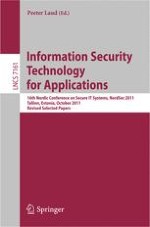2012 | Buch
Information Security Technology for Applications
16th Nordic Conference on Secure IT Systems, NordSec 2011, Tallinn, Estonia, October 26-28, 2011, Revised Selected Papers
herausgegeben von: Peeter Laud
Verlag: Springer Berlin Heidelberg
Buchreihe : Lecture Notes in Computer Science
